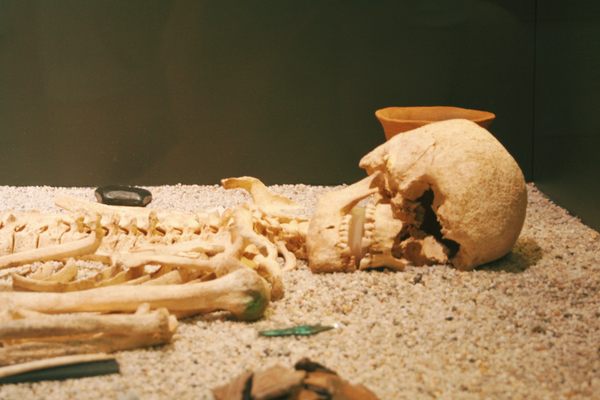Guericke-Einhorn (Magdeburg Unicorn)
This 17th-century "unicorn" was cobbled together from the skull of a rhinoceros, the legs of a mammoth, and the horn of a narwhal.
Bad taxidermy and skeletal reconstruction is always a funny sight to behold. But it is often also interesting as it can be the result of a lack of information rather than a lack of skills. Take for example the Gripsholm Lion, which was based on how lions were depicted on flags rather than in real life, since the taxidermist never saw a real lion. The Magdeburg Unicorn is the result of a similar situation.
Our story starts in 1663, when a strange skeleton was found in a gypsum quarry. In hindsight, we know that this was a combination of several incomplete skeletons, but back then it was thought to belong to one beast and, going by the huge skull and mysterious horn, a very unusual one. The bones were dug up and transported to the local leader of the area where they sat for five years before Otto von Guericke, a famous physicist and mayor of Magdeburg, came over to inspect the creature’s remains.
Not much is known from this reconstruction, except for a description of the bones from a book by Geuricke that was published after his death. “This skeleton was broken and taken out in pieces due to the ignorance and carelessness of the excavators. But the horn, along with the head and some ribs, as well as the spine and some bones, were brought to the local abbess.”
This roused the imagination of many, and some tried to draw what such a skeleton would look like. The drawing that prevailed was an 18th-century version of an artist’s impression by Leibniz based on an earlier drawing by Elke Gröning. We will never know if this was truly how Geuricke had reconstructed the bones, but the image has stuck since then.
The model that you see in the picture is a plastic reconstruction of the drawing, not an actual fossil like many seem to think. It was made in the 1990s by a taxidermist called Urs Oberli.
Ever since then the unicorn seems to be going viral every few years, always with some kind of incomplete story attached to it. However, we should remember that we can learn a lot from it regardless. According to a 2021 publication by Thijs van Kolfschoten, professor of mammalian palaeo- and archaeozoology at Leiden University, the skeleton has the skull of a woolly rhino, the legs of a woolly mammoth, and the horn of a narwhal. How all these animals came to be together in one spot is still a mystery.
Know Before You Go
The unicorn is part of the permanent exhibition of the Museum of Natural History Magdeburg, and can be found just up the main stairs.















Follow us on Twitter to get the latest on the world's hidden wonders.
Like us on Facebook to get the latest on the world's hidden wonders.
Follow us on Twitter Like us on Facebook